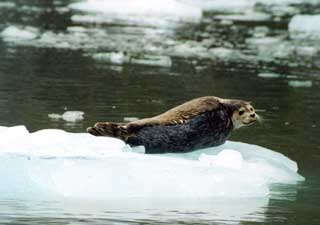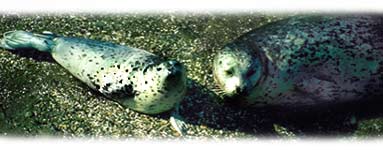Harbor Seal

Common Name: Harbor Seal
Scientific Name: Phoca vitulina
Description
Harbor seals are mammals, that is they are hairy, warm-blooded, air-breathing animals which suckle their young. They weigh about 24 pounds (11 kg) at birth and gain weight rapidly during a month-long suckling period, perhaps doubling their weight. Average weight for adults is about 180 pounds (82 kg); males are somewhat larger than females. They are covered with short, stiff, bristle-like hair. Coloration varies, but two basic patterns occur: a dark background with light rings, or light colored sides and belly with dark blotches or spots. Harbor seals molt annually, usually in late summer.
Harbor seals are well adapted to life in the sea. They are able to dive to depths exceeding 600 feet (183 m) and can remain submerged for over 20 minutes. Oxygen-conserving adaptations that allow such dives include reduced peripheral circulation, reduced heart rate, and high levels of myoglobin (muscle oxygen binder). Harbor seals are graceful and efficient swimmers as they use their hind flippers for propulsion and foreflippers as rudders. Movement on land, however, is slow and laborious.
The harbor seal (Phoca vitulina), a widespread species in both the north Atlantic and Pacific oceans, is found in Alaska along the coast from British Columbia north to Kuskokwim Bay and west throughout the Aleutian Islands. Harbor seals are often called "hair" seals by coastal residents of southern Alaska. Most harbor seals are associated closely with coastal waters, although occasional observations up to 50 miles (81 km) offshore have been made. One radio-tagged animal crossed 45 miles (72 km) of open ocean between two islands in the Gulf of Alaska, and another moved over 50 miles (81 km) from Prince William Sound to Middleton Island. Harbor seals haul out of the water periodically to rest, give birth, and nurse their pups. Reefs, sand and gravel beaches, sand and mud bars, and glacial and sea ice are commonly used for hauling sites. Harbor seals are sometimes found in rivers and lakes, usually on a seasonal basis (present in summer, absent in winter). At Iliamna Lake seals are present year-round and are probably resident. Births of harbor seal pups are not restricted to a few major rookeries (as is the case for many species of pinnipeds) but occur at many hauling sites.
Harbor seals do not appear to make long annual migrations like some species of marine mammals. However, considerable local movements occur. Tagging studies have shown that juveniles move up to 150 miles (242 km) from their birth places. A radio-tagged adult was discovered 120 miles (193 km) from its tagging site. As more seals are being satellite-tagged, much more information is becoming available about winter and summer movements.
Harbor Seal Facts
Winged Foot- The harbor seal is the only pinniped that breeds along Puget Sound. Pinnipeds (seals, seal lions, and walruses) spend part of their lives in the water but depend on land to give birth and raise young. The term "pinniped" comes from the latin word "pinna" meaning winged and "ped" meaning foot.
Small & Spotted- Adults are mottled tan or blue-grey with dark spots, measuring between four and seven feet long, weighing 250 to 300 pounds. To distinguish harbor seals from other pinnipeds along Puget Sound (California sea lions, Northern sea lions, and elephant seals) look for the harbor seal's small size, earless head, and spots.
Deep Diver- The harbor seal can plunge 300 feet and stay underwater up to 28 minutes. It can swim a fast 15 knots.
White Before Birth- Most harbor seal pups shed a white wooly coat before they are born. Sometimes pups are born in the water. Pups can often swim after birth, when the tide returns.
How to Identify Harbor Seals

The harbor seal, northern fur seal, California sea lion, Steller sea lion and northern elephant seal are the five species of pinnipeds a visitor might see at Point Reyes. Harbor seals can usually be distinguished from elephant seals by size alone. The harbor seal is a rather small marine mammal, only getting up to 1.5-1.8 m (five-six feet) in length and 115 kg (250 pounds) in weight, whereas elephant seals are much larger. Bull elephant seals average about 1,360 to 2,500 kg (3,000 to 5,500 pounds), while females range in weight from 360 to 545 kg (800 to 1200 pounds). However, yearling and weaned pups weigh about 135 kg (300 pounds), so a young elephant seal could be mistaken for an adult harbor seal, if one attempts to identify the seal by its size. What color is the seal? While young elephant seals are a uniform gray, harbor seals are typically silver, white or gray, with black spots, although some harbor seals also are black or brown with white spots. Sometimes a harbor seal may have a reddish colored head or body, which is due to iron oxide deposits on the hair shafts.
Harbor seals and elephant seals are in the Family Phocidae (the earless seals) so unlike sea lions and fur seals, they do not have external ear flaps on the head, just a small hole where their ear is. Harbor seals and elephant seals also are unable to rotate their pelvis, and so they drag their body inchworm fashion around on land, on beaches, or other nearshore substrates that have a low slope. Sea lions, in contrast, can rotate their pelvis forward and walk on all four limbs, enabling them to use steep, rocky shoreline habitat unavailable to harbor seals. Harbor seals also differ from sea lions in their smaller size and lighter color. When in water, harbor seals propel themselves with their hind flippers in a sculling motion, and steer with their front flippers, whereas sea lions and fur seals propel themselves with their fore-flippers, like wings.
Life History
The young pups are able to swim almost immediately after birth. They normally remain with their mothers about one month, after which they are weaned and separate from their mother. At that time over half their body weight may consist of fat, providing them a head start on self-sufficiency. Sexual maturity occurs at between 3 and 7 years. Mature females mate shortly after the weaning of their pups; however, the embryo does not implant in the uterus until about 11 weeks later, a trait called delayed implantation. Active fetal development is about 8 months.
The sex ratio of harbor seals at birth is approximately equal and remains so until about 5 years of age. Thereafter mortality rates for males are higher, and females become relatively more abundant. Maximum ages estimated from annual rings in their teeth are 26 years for a male and 32 years for a female.
Diet
Commonly eaten prey include walleye, pollock, Pacific cod, capelin, eulachon, Pacific herring, salmon, octopus, and squid.
Harbor seals are within the Order Carnivora, which means that they primarily eat meat. The meat they eat is fish in the nearshore waters of the park, such as herring, anchovies, sardines, hake, flounder, sole, salmon and sculpin. They also eat invertebrates such as octopus and squid and even crabs. The harbor seal is considered an "apex predator" because it feeds towards the top of the food chain. Apex predators are often used as an indication of the condition of their ecosystem because they can't do well unless all of the organisms within their habitat are doing well. Point Reyes has been using the harbor seal as one of the indicators of the condition of the area's marine systems. The population has grown and stabilized over the past decade and females give birth to pups around every year. During El Nino years, though, female seals often skip giving birth and the population counts onshore are lower, likely because seals are spending more time in the water looking for food.
What Eats Harbor Seals?
White sharks are the primary marine predator of harbor seals, but occasionally other large sharks and killer whales eat them. Terrestrial predators such as coyotes and bobcats can also occasionally prey on harbor seals resting onshore, particularly pups that are very young.
Rarely, male elephant seals have been documented killing harbor seals in California at harbor seal colonies such as Jenner. This elephant seal behavior is very unusual, and the male seals do not appear to interact or haul out with other elephant seals. Instead, they haul out at harbor seal colonies.
Hauling Out
Harbor seals (and sea lions) haul out (come out of the water) almost daily to rest and to warm up. They cannot maintain their body temperature if they stay in cold water all the time because of their smaller size and thinner blubber layer. Northern elephant seals lose less heat than harbor seals because are much larger and have a thicker blubber layer that allows them to stay at sea for months at a time before coming onshore to rest and give birth.
All pinnipeds give birth on land, and that is one fact that distinguishes them from cetaceans, another group of marine mammals. Harbor seals give birth between March and June on tidal sandbars, rocky reefs and pocket beaches. They can give birth on areas which are inundated at high tide because harbor seal pups, unlike most pinniped species, can swim at birth. During the pupping season, mother seals will spend more time onshore nursing pups and resting, for an average of around 10-12 hours per day. The mother harbor seal stays with the pup almost continuously and rarely leaves the pup alone onshore. Mothers can take their pups with them when they go swimming and feeding because pups are adept swimmers.
A mother caresses and nuzzles its baby pup constantly, and for four to six weeks nurses it with her rich milk. The 48% fat content of milk makes the pup gain weight rapidly, and by around 30 days they are weaned. Pups weigh around 11 kg (25 lbs) at birth but when they are weaned they may weigh as much as 22 kg (50 lbs).
During the breeding season, male seals hold territories in the waters adjacent to where females haul out on shore, called maritory. Females are receptive to mating around when the pups are weaned and mating occurs in the water. Male seals will protect their maritory from other males and engage in stylized fighting during the breeding season.
Shortly after the pups are weaned, the seals begin their annual molt of their sea worn fur. The fur sheds much like a dog and the seals turn a luminous color with new fur. The molt period begins around mid-June and extends through July. During this time, seals will spend more time resting onshore because it is energetically taxing. Also, studies have shown that hair follicles grow faster in onshore than in the water. Seals can stay onshore resting for an average of 12 hours per day during the molt compared to around 7 hours per day during fall-winter months.
Abundance and Trends
Harbor seals are a difficult species to census because they can be accurately counted only when they are hauled out. They haul out in thousands of locations in Alaska, and even if seals at all sites could be counted, the proportion of the total population hauled out at any given time is unknown. The total Alaska harbor seal population probably ranges between 200,000 and 300,000 animals. Since implementation of the Marine Mammal Protection Act in 1972, hunting has been restricted to Alaska Natives. In some areas, harbor seals are an important part of the subsistence economy. The annual harbor seal harvest is about 2,500 to 4,000 animals.
The number of harbor seals has declined in several areas of the Gulf of Alaska and Prince William Sound since the mid 1970s. At Tugidak Island near Kodiak, numbers have declined 90 percent from approximately 11,000 seals to 1,000. The reasons are unknown
 Deep Sea Crabs
Deep Sea Crabs